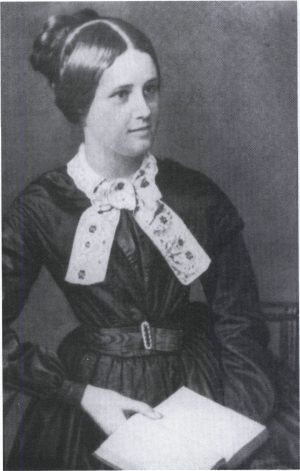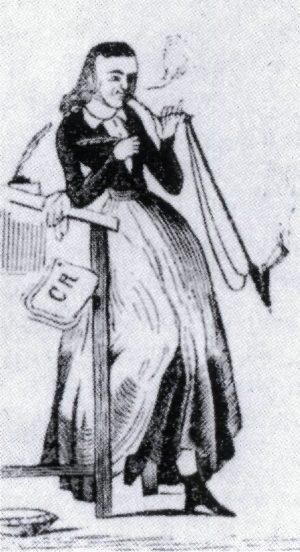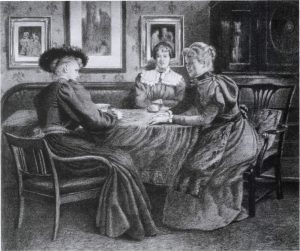In Sweden, a debate about marriage and the comparative status of man and woman within marriage was sparked off by Carl Jonas Love Almqvist’s novel Det går an (1839; It Can Be Done). This particular issue was not addressed by Danes until a decade later, and in Denmark it was a novel written by a woman, Mathilde Fibiger’s Clara Raphael. Tolv Breve (1851; Clara Raphael. Twelve Letters), that provoked the dispute. The book was published at Christmastime in 1850, and although the leading literary authority of the day, manager of the Royal Danish Theatre Johan Ludvig Heiberg, had supplied a long and placating foreword, the subject matter provoked great controversy. Within a year, the book had generated almost twenty-five newspaper and periodical items, and ten pamphlets had been published on the matter.
The national mood of enthusiasm in those March days of 1848 inspired Peter Faber to write the soldier song “Den Gang jeg drog af Sted” (The Day I Left for War), which was printed as a broadsheet ballad and quickly sold 18,000 copies; lines three and four tell us that “min Pige ville med – ja, min Pige ville med” (my girl wanted to come along, too – yes, my girl wanted to come along, too), and that was what Mathilde Fibiger wanted to do as well.

Denmark was in the middle of the Three Years’ War with Germany, a conflict centred on control of the Duchies of Schleswig and Holstein, and absolute monarchy had been dispensed with after the accession of the new king in 1848. At the age of seventeen, Mathilde Fibiger had seen the troops marching out of Copenhagen on their way to war and the crowd marching on the palace to demand democracy. She had subsequently travelled south to the island of Lolland, working as private tutor to a forester’s family; it was here, in the course of a few months, that she wrote her novel.
“But only what is true and free is truly beautiful,” wrote Clara. “Nothing is beautiful except that which is true and just,” stated Georg Brandes nineteen years later, using almost identical wording, in the foreword to his translation of John Stuart Mill’s The Subjection of Women. Brandes never denied, however, that he had a predecessor and an ally in Fibiger.
Clara Raphael consists of twelve letters from Clara to her friend Mathilde, dating from 8 November 1848 to 7 July 1849. Clara writes that, being an orphan, she has left the confines of the home she shared with her aunt in Copenhagen and has gone “into the big outside world to be of use”. She takes a position as governess in the household of a tenant farmer in the provinces, but life here soon makes her think she has landed in a petit bourgeois hell. Her departure had been inspired by the mood of national enthusiasm awakened by the war and the political upheavals. Now she is stuck out in the countryside and has not found the mission in life she had sought.
At this point she has an idea: that it is her sex that stands in her way. Were she a man there would be enough assignments to address: “For the first time in my life I feel sorrow that I am not a man.” All of her youthful, outgoing energy, which is inhibited by her lack of clear goals, is now turned against the inhibiting factors that she has identified: men and their prejudices. “How poor and empty are not our lives compared with theirs? Is it justifiable that half of humankind is excluded from all intellectual occupation? Or has the good Lord really made us of lesser stuff than men […] so we must content ourselves mechanically to carry out the humdrum work assigned to us here in life?
Have our minds not vigour and our heart not keenness? Oh indeed, but the actual life in us has not become conscious, our intellect is held captive, and prejudice stands sentry at its prison.”
Clara’s purpose with her letters thus becomes to supplant these prejudices, to criticise the male glorification of women that is a cover-up for repression, and to show that women have or can acquire their own identities: “We do not wish to usurp mastery of any domain, but simply to be mistresses of ourselves by means of the power of free will”; they can have or can acquire their own life ambitions: “The ingredients of something immensely splendid lie in our nature”; and their own language:
“For since I read his [the writer Poul Martin Møller] remarks that we [women] were unable to clarify our ideas, from lack of occasion to express them in words, I have been consumed by a speech-rage that knows no bounds.”
Mathilde Fibiger was extremely well-read; she was familiar with the work of George Sand, about whom she wrote to her sister:
“Have you started reading George Sand – after all, you speak about knowledge of human nature […] which you can only have learned from her, the most initiated of all authoresses initiated in knowledge of human nature.”

In spite of its clear analysis of the view of women prevalent in her day and these frank assertions about the goal of female emancipation, the message in the novel is ambiguous. What did Clara actually want? Her ideal of womanhood is the same as that of Romanticism: the woman must manifest “the notion of beauty”, “the animating spirit, the deep rapture and childlike faith in the fundamental nature of her being.” Thought of taking on men’s political rights, financial dealings, or academic studies are far from her mind: “The day will never come when you see me pipe in mouth, immersed in learned investigations in the dusty study.”
Statements such as these suggest that Clara wants to release the specifically feminine in the female. In other passages she refers to women being “oppressed”, that their upbringing puts them in a “mental corset”, and that “freedom is the only fortune”. Here the style is coloured by the liberal, political rhetoric of the day; as regards ‘feminist’ content, emancipation of women is expressed in terms of the societal equality with men achieved some decades later by the campaigning women’s movement Dansk Kvindesamfund (Danish Women’s Society, established 1871).
To the fictional penfriend’s repeated questioning, Clara finally sums up her views in this statement: “I will fight, breathe for what I understand by the emancipation of ladies” and she defines just how by quoting the Swedish poet Esaias Tegnér: “And fight for the good of humankind with pen, with voice!”
The Tegnér quotation is taken from a poem entitled “Till en yngling” (1810; For a Youth), but Fibiger has made an important revision. Where she writes “by pen, by voice”, Tegnér had written: “by sword, by voice”. She has replaced the man’s weapon, the sword, with the gender-neutral pen, while also showing what the pen could symbolise for women writers at the time.
The aesthetic form of Clara Raphael was flawed by Fibiger’s inability to integrate these ideas of liberation, which were the incentive behind the writing process, into the structure of a story. It is not until late on in the book, in the ninth letter, that an actual storyline is launched. Clara has promised God to forsake happiness in this life and to fight for her ideas. Not long afterwards, she meets young Baron Axel and they fall in love. Having experienced erotic passion, Clara is close to giving up on her promise, but she stands firm – and gets Axel anyway. He suggests that they should live like husband and wife “for the world”, but “for God and one another they would live together like affectionate siblings”. On top of that, he goes off to war.
Clara Raphael. Tolv Breve was published on December 20 1850 in 800 copies. Mathilde Fibiger was paid a honorarium of 120 Rigsdaler, which corresponded to what she could earn in a year running an infant school. She immediately gave 20 Rigsdaler to the “Komitéen for de Faldnes Efterladte” (Committee for the Surviving Relatives of the Fallen). The furore provoked by the novel made a second print run necessary after a couple of months. The third impression was printed in 1893, after Johanne Luise Heiberg’s memoirs had reawakened interest in the period, and the fourth impression was published by Eva Bendix in 1976, while the women’s liberation movement was in full swing.
With this curious and implausible conclusion, Mathilde Fibiger wanted to salvage Clara’s personal integrity so that in the future, too, she could breathe for her ideas and not just for her husband. On another level, it is a very traditional ending: opposites are harmonised, Clara gets her ‘prince and half the kingdom’, and when all is said and done, it is Axel who goes to war to fight for the couple’s shared ideals.
The novel caused annoyance in every political camp. The demands for equality provoked particular furore. The conservative wing took the opportunity to sing the praises of their womenfolk in the home, while paternalistically keeping them in their subservient place. The right-wing newspaper Berlingske Tidende put a poem “Til Clara Raphael” on the front page (11 January 1851; To Clara Raphael). The poem was signed “En Røst fra Danmarks unge Kvinder” (A Voice from the Young Women of Denmark), three of the lines stating:
Learn first the proper light of truth to see! Go to Bethlehem, where it was lit, … for Christ alone can set a woman free.
Julius Gerson, a man who wrote children’s literature, published the pamphlet Fem Breve til Clara Raphael fra en ung Hustru (1851; Five Letters to Clara Raphael from a Young Wife) under the pseudonym “en ung Hustru” (a young wife). This “young wife” claims that Fibiger’s novel has offended the female sex and that “the feelings and the cravings submitted as women’s highest were alien to the true woman”. “She” praises herself for being “a young mother who is nothing and who has no wish to be anything beyond her circle”.
At the opposite end of the political spectrum, Denmark’s first socialist, Frederik Dreier, regarded the gender battle as but a subordinate factor in the fundamental class struggle. In the pamphlet Blik paa det verdenshistoriske Værk “Clara Raphael” og den derved fremkaldte Dameliteratur (1851; A View of the Historic Work “Clara Raphael” and the Ladies’ Literature thus Generated), he wrote, under the pseudonym Peter Vandal:
“The scant difference there is between the man’s and the woman’s degree of liberty is somewhat negligible compared with the equality in the bondage where their common prejudices keep them on the larger societal treadmill.”
In Dreier’s opinion, all “petty critiques” of society should “be absorbed into the wider general social critique”. His vision of a new society based on equality involved “the thorough eradication of womanishness”.
Between these two extremes, the liberals sought concrete recommendations for reform. Writing under the pseudonym “a” in the liberal newspaper Fædrelandet (8 January 1851; The Fatherland), Hans Egede Schack referred to the more progressive educational policy in America and was sorry that Clara, being a teacher, had not provided “a critique of the prevalent philistine upbringing of females”.

The requested recommendations for reform were soon proposed by two female voices in the debate: Pauline Worm (1825-1883) and Athalia Schwartz (1821-1871). They were teachers, and they used the controversy surrounding Clara Raphael as a lever to promote the claim for an improved educational system for girls – which they thought should be the most important objective of the ‘women’s movement’. During the 1850s, they made many written contributions to the lengthy public dialogue about schools for girls, and they had an impact on later developments in the debate. In addition, they both became writers of fiction.
Clara’s most abstract notions of liberation were not, however, to the liking of either Schwartz or Worm. Schwartz wrote two polemic pamphlets – Betragtninger over den grasserende Emancipationsfeber (1851; Reflections on the Raging Emancipation Fever) and En Contravisite hos Clara Raphael (1851; A Return Visit to Clara Raphael) – in which she criticised the vague and utopian aspect of Fibiger’s ideas. Worm, in her Fire Breve om Clara Raphael til en ung Pige fra hendes Søster (1851: Four Letters about Clara Raphael, to a Young Woman from her Sister), wrote: “A life devoted to reflection, without deed, was a life without purpose in the world and without advantage to the world”; she then offered a critique of low standards at girls’ schools resulting from the poor pay, lack of training, and low social status endured by the schoolmistresses. She also turned fiercely on marriages in which the woman was maintained by the man.
Mathilde Fibiger’s only real ally was twenty-three-year-old schoolmistress Fanny Normand de Bretteville (1827-1859), who got into a discussion about the novel with Meïr Aron Goldschmidt in his journal Nord og Syd and wrote the pamphlet En Brevvexling om Qvindens Stilling i Samfundet (1851; A Correspondence on Woman’s Position in Society). She understood Clara’s need to experience her individuality as something quite distinct from the male description of the female being: “While the man perceives himself correctly, his perception of the woman easily becomes biased and blinkered in that he perceives her in relation to himself.” When putting Mathilde Fibiger’s basic idea into words, Fanny Normand de Bretteville is almost more coherent than Fibiger herself: woman will be liberated as a human individual by fortifying her self-awareness as woman,
“[…] so bring her up to acknowledge her own law – only then will she own what it is to be a human being, only then will she understand and have freedom; first then will she be a self!”
Mathilde’s family had deep reservations about her questionable renown. A heated exchange of letters prevented her from speaking from the platform at a summer rally on 25 July 1852. She wanted her own place to live, and in order to claim this right she had to threaten to starve herself to death.
Mathilde Fibiger contributed two pamphlets to the controversy, and they made it even more apparent that fortifying women’s self-awareness was indeed her key intention. She addresses “my women readers” and signs herself “your sister”. In Hvad er Emancipation? (1851; What is Emancipation?), she tells those zealous for reform that women’s areas of work would have to be expanded as a result of emancipation, but this should not in itself be mistaken for emancipation. In Et Besøg (1851; A Visit), women’s enclosure within the woman’s role is compared to a nun who takes the veil. She entreats her female readers to give themselves over to their own nature and to life. The objective of the grand epiphany is “to take us in spirit to stand before God, face to face”. Fibiger wants to strike at the very core of the gender relationship as interpreted by western culture and as summed up in John Milton’s Paradise Lost (1667), Book IV: “He for God only, she for God in him”. Her final novel, Minona (1854), incorporates a far clearer attack on the law of the father.
Mathilde Fibiger was not a robust woman, and the controversy taxed her energy. In a letter of August 1851 she wrote:
“[…] I am well, apart from the fact that I am knocked down every day in a mental sense, for I have a vivid impression that every carriage driving past on the road rolls right through my brow and by so doing mangles the poor thoughts that have lodgings there.”
How could Heiberg, a central establishment figure, take it into his head to write the foreword for a book like Clara Raphael. Tolv Breve? The answer is that Fibiger’s demands for equality in respect of education and employment, demands which the political theorists took to task, did not interest him, and her demands for a free development of the female mind fitted in with his own Romantic agenda. A letter he wrote to Fibiger ahead of publication did, however, register some degree of concern about the ultimate objective of her emancipation project: “In my opinion, irrespective of Clara’s views and talent for exposition, such rigorous, such manly personal conduct is a little denial of the feminine humility, of the innocent modesty […] Thus, in other words: despite all Clara’s agreeableness, there is something about her that the world, at least, would call unwomanly.”
“If you have chosen me to be your knight on the battlefield of literature, then I shall assuredly not excuse myself from carrying your colours in my shield,” wrote Heiberg gallantly to Mathilde before publication. However, during the controversy, which took him completely by surprise, he remained passive.
Clara Raphael. Tolv Breve has always been looked upon as the first manifesto of the women’s movement in Denmark, and the Danish Women’s Society considers Mathilde Fibiger to be its first major public figure. The novel’s message might well be ambiguous, but the attempt to express a total female subjectivity speaks to us over and across the radical changes that have since shaped women’s lives.
Translated by Gaye Kynoch

